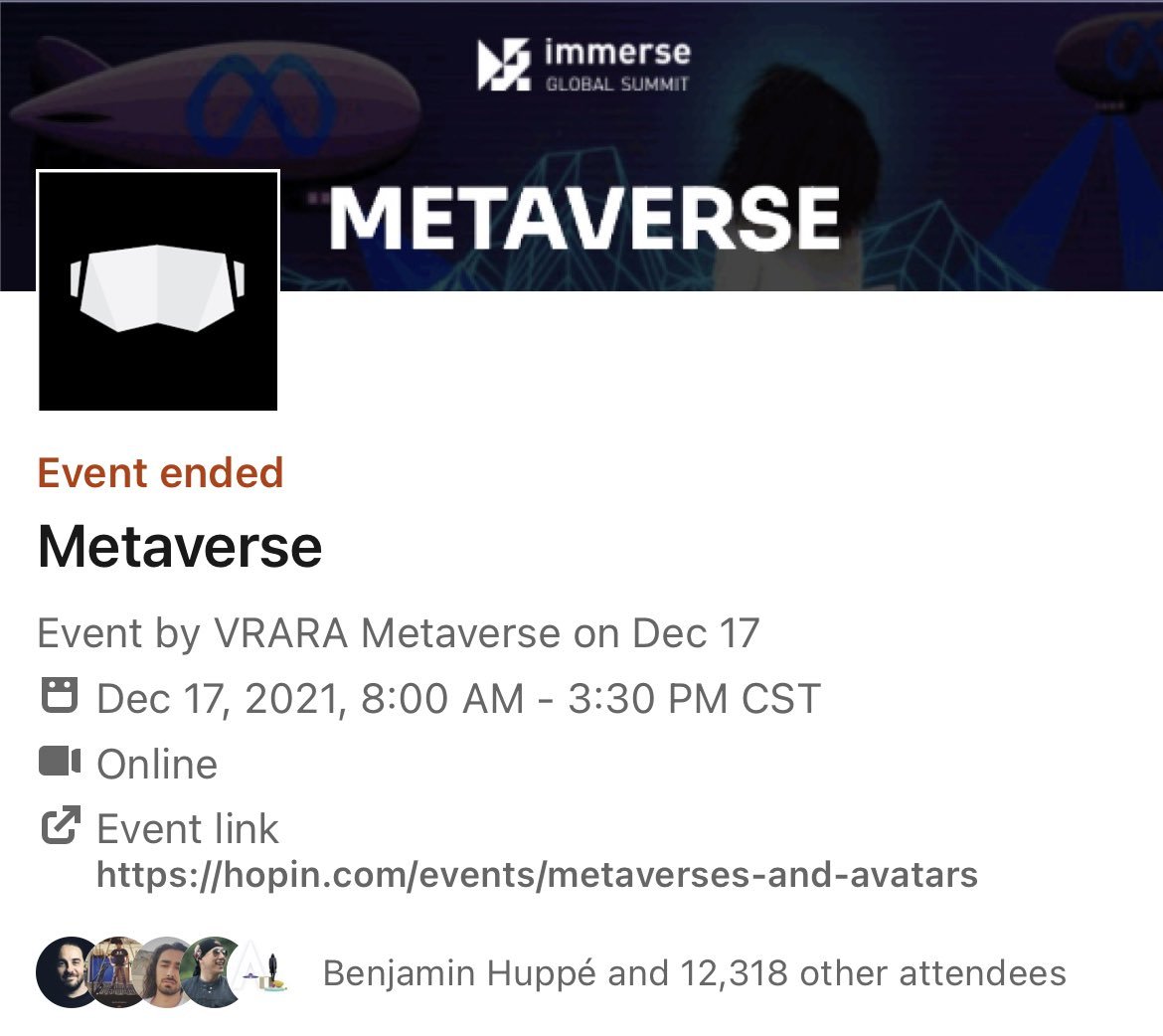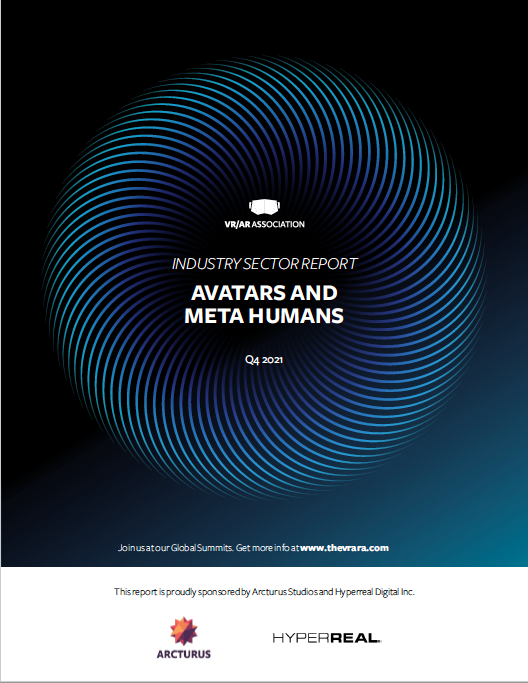By Jon Jaehnig
VR/AR Association Holds Virtual Summit Dedicated to the Metaverse
A conversation about the metaverse from the people building, living, and working in it.
Last Friday, December 17, The VR/AR Association held a one-day event dedicated to the metaverse and avatars as part of the Immerse Global Summit Series. With so much buzz around the term generated by people outside of the industry, this free one-day summit was a welcome opportunity for bonafide experts to comment on the situation.
We weren’t able to attend all of the sessions, and as of this writing, recordings have not been made publicly available. But, presented here are some of the highlights and takeaways from the event.
NFT Talk
A surprising number of sessions focused on NFTs. While many have dismissed non-fungible tokens as scams, a number of speakers praised them as the key to interoperability and creating value across virtual spaces.
Seek Announces NFT Platform
During the opening Keynote, “Interoperability Across the Metaverse,” Seek CEO Jon Cheney announced the Seek NFT platform.
“I think, in the future, all of this content is going to be in 3D. When we jump into these different places, they’re going to be in 3D,” said Cheney. “We’re excited today to announce Seek NFT. Mint directly to the NFT platform of your choice directly from Seek.”
The session, co-hosted by Dude Perfect Chief Strategy Officer Jordan Harbbertson, concluded with the opening of the auction for the first Dude Perfect NFT minted with Seek with proceeds to benefit the VR/AR Association. Many in the public comments section expressed disinterest in being sold an NFT during a keynote address, but that seems to be the way of the world these days.
Victoria VR Launch
Mario Valle Reyes, co-founder and Managing Partner of Altered Ventures, hosted a session titled “The Metaverse and Its Unlimited Potential With Blockchain.” During this panel too, Reyes spoke of blockchain technologies as the link not just between virtual worlds, but between virtual worlds and the physical world to create true interoperability across immersive platforms.
“The metaverse is about more than VR,” said Reyes. “How are we going to transport attributes from the physical world to the digital world?”
The session launched Victoria VR, a blockchain-enabled worldbuilding game that Reyes had also teased at the 2021 VR/AR Global summit.
“We see the future of Victoria VR as a universal platform for VR experiences,” Victoria VR co-founder and CEO Adam Bém said during the Global Summit session. “To create not just a game, but a virtual world where people are able to live and work.”
Creator Economies in AR and Web3
A number of panel speakers linked the idea of augmented reality and “Web3” as the real way to link digital assets and real-world opportunities.
Value From Virtual Worlds
“The time and effort and resources spent in virtual worlds gives users no real control… virtual worlds lose their relevance when a new virtual world comes out,” SuperWorld co-founder and CEO Hrish Lotlikar said in his panel “A Virtual World That Enhances People’s Real Lives.” “Web3 really solves that… NFTs are really the building blocks of all of this.”
Lotlikar didn’t call out NFTs as a lone hero, but part of the Web3 movement. To him, that includes AR content creation tools, the AR Cloud, spatial computing, and consumer AR glasses.
“SuperWorld is not just a technology company, but a movement of people who want to be in our community,” said Lotlikar. “We have an opportunity to build a world that empowers all of us.”
Empowering Creator Economies
“We are at a turning point in history where we have the technology to decide what we want to be… The challenge now is if we are going to be able to drive adoption to this kind of technology,” said OVR co-founder and PwC senior advisor Diego Di Tommaso. “Ownership created incentives for people to participate in the metaverse.”
Verifiable ownership of digital assets driving adoption isn’t the only point on which Di Tommaso and Lotlikar agree. Di Tommaso also emphasized the importance of AR to the conversation that is so often dominated by VR.
“VR is going to be big – even bigger than it is now – but at the end of the day, we are physical beings and we live in a physical world,” said Di Tommaso. “We’re not going to want to spend all of our time with these big glasses on.”
Non-Human Agents in the Metaverse
Whether you call them “embodied AIs,” “virtual beings,” or whatever else, the idea of artificial intelligence that looks just like you and I in virtual worlds got some considerable discussion time.
Charisma CEO Guy Gadney presented “Characters in the Metaverse” with writing lead Rianna Dearden. Charisma is a platform for “powering conversational characters” built with AI. AI is then digitally embodied through Unreal Engine, Unity, Metahuman, or Ready Player Me.
Also present was Virbe founder and CEO Chris Wrobel. Virbe is also for creating intelligent virtual beings by matching one of four digital character creators with one of four conversational AIs, with capacity for more possibilities through SDKs and custom integrations.
“It’s not only about one reality, one device, it’s about bridging realities,” said Wrobel. “Virtual beings are the bridge for one person or one company to be present in the metaverse 24/7.”
The Metaverse for Enterprise and Education
Those speakers weren’t the only ones aware of virtual beings. VR/AR Association Education Committee cochair Carlos Ochoa called for “regulation for metahumans” during his panel “Are We Ready for Meta Education? A World Beyond Augmented Learning.” Panels on education and enterprise were also more grounding in terms of the current value of virtual worlds today.
“Meta Education”
“Meta Education is education that can take place in the metaverse,” futurist Dr. Colleen Bielitz said in the Meta Education Panel. “Meta education is going to see the same kind of threats as in-person education.”
Multiverse Institute For Arts & Technology founder and CEO Elisabetta Rotolo stressed that these kinds of concerns are significant because the value in virtual worlds comes from interactions with other humans facilitated by the technology – not by the technology itself.
“Context emerges in the metaverse, even now, from people’s interactions with each other,” said Rotolo. “The metaverse needs to be conceived, designed, and built by storytellers.”
Because we learn from other individuals in virtual worlds, we need to be careful about who we learn from, according to Mike Christian, CEO of From the Future LLC. Unfortunately, this problem is made more complicated by the fragmented and early stage of the technology.
“From my understanding of the metaverse, there is no metaverse today – so to speak. There are smaller projects, ‘microverses,’” said Christian. “As we get into the metaverse and education we want to trust that what we’re learning is true.”
The Metaverse for Work
Christian’s sentiments were echoed by Head of North America at Glue, Adam Lorimer, in his session “The Metaverse at Work Today.”
“Don’t wait for the big-M metaverse,” said Lorimer. “There are dozens of smaller metaverses out there and you can experience them today.”
Enterprise conversations at the summit also echoed the education conversation that, for all of its shiny tech, the real value of the virtual worlds is connecting people, though that tech does facilitate new kinds of connections.
“The human connection in enterprise has evolved significantly in the last few years,” Cavrnus CEO and founder Anthony Duca said in a talk on “The Metaverse and Hybrid Work.” “One of the things that the metaverse provides is that we don’t need to recreate the real world. You can create these dynamic spaces that are persistent.”
Duca also announced an upcoming update to his platform in partnership with Epic Games to focus on increased performance.
Immerse Returning to In-person
The icing on the cake from this summit was the announcement that the Immerse Global Summit will be returning to an in-person venue in 2022. The summit is scheduled to take place from December 5-7, 2022, in Miami Florida.
Source





